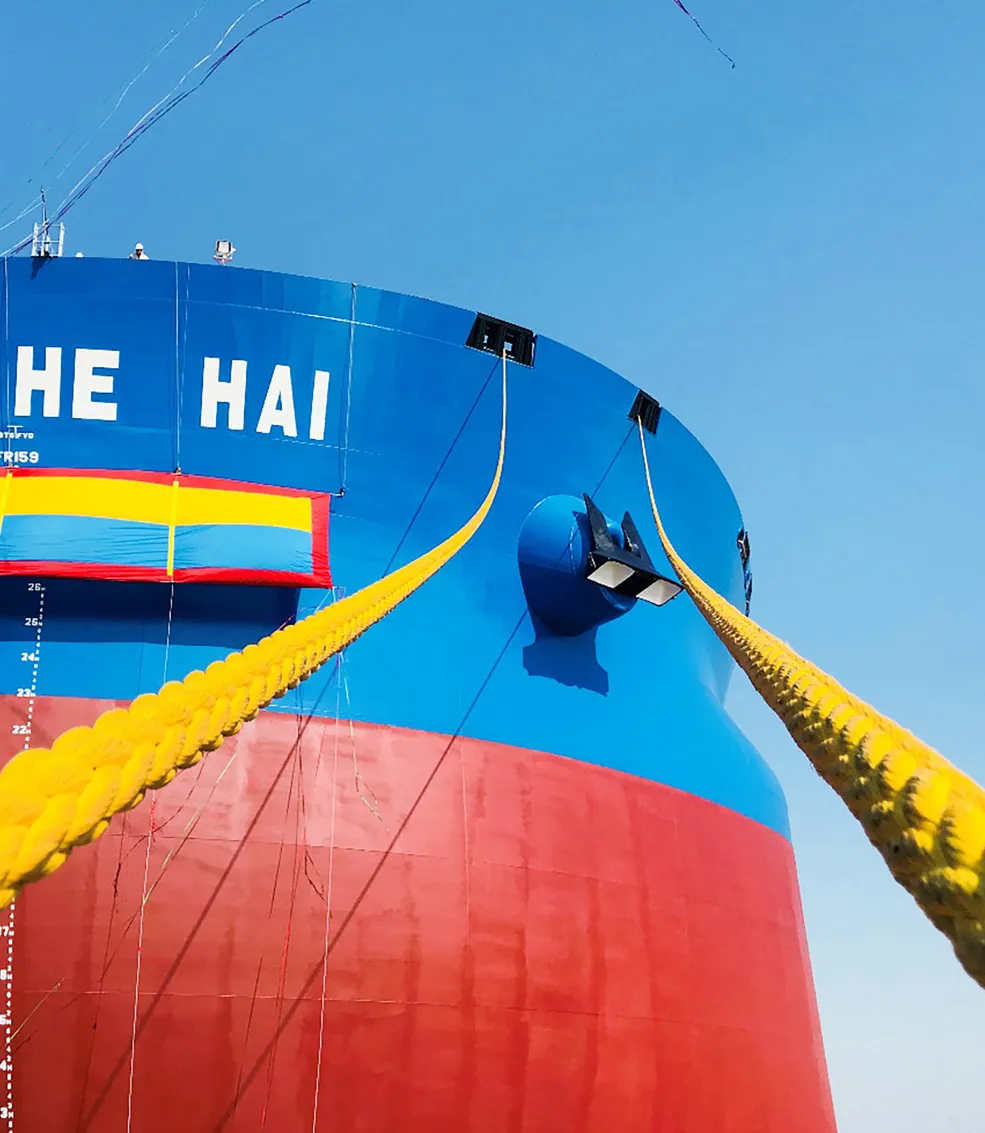Ore carrier champion
The world’s largest dry cargo vessel to date was delivered in January 2018. Designated a specially constructed or fitted cargo ship, she will be able to carry ore with a high moisture content. DNV GL accompanied the complex project, helping incorporate several class notations into the design.
On a sunny morning in January 2018, Yuan He Hai, the first vessel of the second 400,000 dwt ore carrier series chartered by Vale, was delivered to China Ore Shipping, a subsidiary of China COSCO shipping, by Shanghai Waigaoqiao Shipyard (SWS). The festive naming ceremony was attended by the Vice President of COSCO Shipping, Huang Xiao Wen, the Vice President of CSSC, Nan Da Qing, the President of SWS, Sheng Ji Gang, and 80 other VIP guests, site project team members and DNV GL representatives.
During the naming ceremony, SWS President Sheng Ji Gang expressed his sincere appreciation to DNV GL: “Your professional work has made it possible for us to maintain a high quality level and deliver this complex vessel three months ahead of schedule. Without your strong support, we could not have achieved this great success!”

Class notations demonstrate future-readiness
SWS is one of the most advanced and efficient shipyards in China, and Yuan He Hai is currently the world’s largest dry cargo ship.Based on the experience gained with the first generation of Vale’s very large ore carriers (VLOCs), the hull structure was optimized and many new notations were added for the second generation of these ships, such as “Clean”, “HMON”, “Gas ready”, “Shore power”, in keeping with the motto “Safer, Smarter, Greener”:
Gas Ready: The vessels are designed with the Gas Ready (D, MEc, S) notation, which indicates that they can be easily converted to operate on LNG fuel. The LNG-related design features comply with the requirements of the “Gas Fueled” notation, and the main engine can be converted to dual-fuel operation. A space located between the engine room and the aftmost cargo hold can accommodate an LNG tank. The relevant structural components are strengthened for future installation of a type B or membrane LNG tank.
Liquefaction: Iron ore fines with certain properties that are categorized as group A cargo may liquefy if the moisture content (MC) exceeds the transportable moisture limit (TML). By agreement between the charterer Vale and the owner, the design was developed as a specially constructed or fitted cargo ship pursuant to the IMO’s IMSBC Code, featuring special arrangements that account for the particular stability requirements when carrying cargo with a moisture content above the TML.DNV GL acts on behalf of the shipyard in helping SWS fulfil its contractual obligations towards the owner and charterer. As this is the industry’s first vessel designed with the stability features stipulated for the Liquefaction requirements, DNV GL approached the flag state to engage in a thorough discussion regarding the technical details and safety analysis. Both Singapore MPA and the Hong Kong Marine Department gave their approval.
Single pass loading: The new VLOCs are designed for a higher loading rate (24,000 tonnes/h versus 16,000 tonnes/h for the previous VLOC generation) to make cargo loading more efficient and shorten loading times. Higher-capacity deballasting pumps make sure the deballasting rate matches the loading rate.
HMON: Yuan He Hai and her sister vessel are equipped with a certified hull monitoring system, with sensors measuring hull girder loading and collecting data for decision support
Implementing the requirements of these class notations was challenging for the designers and the yard since this was the first VLOC project of this size and complexity. “DNV GL places great emphasis on supporting customers extensively in projects involving highly sophisticated and unusual specifications”, Boris Bondarenko, Area Manager South China points out. “In this project we took proactive measures from the beginning to facilitate the integration of all requirements into the design.” Regular multiparty meetings were arranged to support the communication and collaboration of all involved partners. Workshops were led by experts from TCC to share relevant knowledge. A project steering committee was set up to coordinate activities and allocate resources internally. Bondarenko further underlines: “With the joint efforts of all project members, we could overcome all challenges successfully.”


Ready for the sister vessel
DNV GL’s expert team in China not only helped maintain a very smooth and efficient communication channel with the flag state but also supported the shipowner’s staff in familiarizing themselves with flag requirements prior to preparing registration and filling all documents. The outstanding cross-regional teamwork laid down a firm foundation for timely delivery and left a very positive impression with the customer. “Without the strong support from DNV GL we would not have been able to finish the registration in such a short time,” says Zhang Fu Guang, President of China Ore Shipping.
Now that the first part of the project has been completed successfully, the project team is determined to deliver the second Vale VLOC to China Ore Shipping with the same high quality and in the same customer-centric manner so as to achieve unequivocal customer satisfaction.
